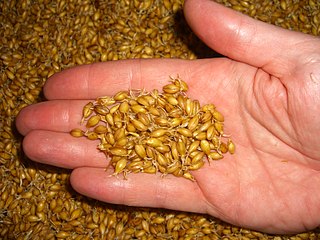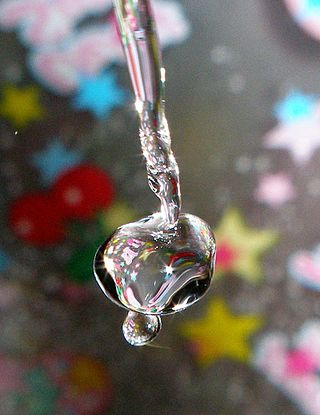Related Research Articles

Glucose is a sugar with the molecular formula C6H12O6. Glucose is overall the most abundant monosaccharide, a subcategory of carbohydrates. Glucose is mainly made by plants and most algae during photosynthesis from water and carbon dioxide, using energy from sunlight, where it is used to make cellulose in cell walls, the most abundant carbohydrate in the world.

Malt is germinated cereal grain that has been made to germinate by soaking in water and is then halted from germinating further by drying with hot air, a process known as "malting". Malted grain is used to make beer, whisky, malted milk, malt vinegar, confections such as Maltesers and Whoppers, flavored drinks such as Horlicks, Ovaltine, and Milo, and some baked goods, such as malt loaf, bagels, and Rich Tea biscuits. Malted grain that has been ground into a coarse meal is known as "sweet meal".

Starch or amylum is a polymeric carbohydrate consisting of numerous glucose units joined by glycosidic bonds. This polysaccharide is produced by most green plants for energy storage. Worldwide, it is the most common carbohydrate in human diets, and is contained in large amounts in staple foods such as wheat, potatoes, maize (corn), rice, and cassava (manioc).

Sugar is the generic name for sweet-tasting, soluble carbohydrates, many of which are used in food. Simple sugars, also called monosaccharides, include glucose, fructose, and galactose. Compound sugars, also called disaccharides or double sugars, are molecules made of two bonded monosaccharides; common examples are sucrose, lactose, and maltose. White sugar is a refined form of sucrose. In the body, compound sugars are hydrolysed into simple sugars.

Fructose, or fruit sugar, is a ketonic simple sugar found in many plants, where it is often bonded to glucose to form the disaccharide sucrose. It is one of the three dietary monosaccharides, along with glucose and galactose, that are absorbed by the gut directly into the blood of the portal vein during digestion. The liver then converts both fructose and galactose into glucose, so that dissolved glucose, known as blood sugar, is the only monosaccharide present in circulating blood.

Corn syrup is a food syrup which is made from the starch of corn and contains varying amounts of sugars: glucose, maltose and higher oligosaccharides, depending on the grade. Corn syrup is used in foods to soften texture, add volume, prevent crystallization of sugar, and enhance flavor. Corn syrup is not the same as high-fructose corn syrup (HFCS), which is manufactured from corn syrup by converting a large proportion of its glucose into fructose using the enzyme D-xylose isomerase, thus producing a sweeter substance.

Marshmallow is a type of confectionery that is typically made from sugar, water and gelatin whipped to a solid-but-soft consistency. It is used as a filling in baking or normally molded into shapes and coated with corn starch. The sugar confection is inspired by a historical medicinal confection made from Althaea officinalis, the marsh-mallow plant.

Maltose, also known as maltobiose or malt sugar, is a disaccharide formed from two units of glucose joined with an α(1→4) bond. In the isomer isomaltose, the two glucose molecules are joined with an α(1→6) bond. Maltose is the two-unit member of the amylose homologous series, the key structural motif of starch. When beta-amylase breaks down starch, it removes two glucose units at a time, producing maltose. An example of this reaction is found in germinating seeds, which is why it was named after malt. Unlike sucrose, it is a reducing sugar.

Mizuame is a sweetener from Japan. A clear, thick, sticky liquid, it is made by converting starch to sugars. Mizuame is added to wagashi to give them a sheen, eaten in ways similar to honey, and can be a main ingredient in sweets. Some Mizuame are produced in a very similar fashion to corn syrup and are very similar in taste.

Brown rice (malt) syrup, also known as rice syrup or rice malt, is a sweetener which is rich in compounds categorized as sugars and is derived by steeping cooked rice starch with saccharifying enzymes to break down the starches, followed by straining off the liquid and reducing it by evaporative heating until the desired consistency is reached. The enzymes used in the saccharification step are supplied by an addition of sprouted barley grains to the rice starch or by adding bacterial- or fungal-derived purified enzyme isolates.

High-fructose corn syrup (HFCS), also known as glucose–fructose, isoglucose and glucose–fructose syrup, is a sweetener made from corn starch. As in the production of conventional corn syrup, the starch is broken down into glucose by enzymes. To make HFCS, the corn syrup is further processed by D-xylose isomerase to convert some of its glucose into fructose. HFCS was first marketed in the early 1970s by the Clinton Corn Processing Company, together with the Japanese Agency of Industrial Science and Technology, where the enzyme was discovered in 1965.

Glucose syrup, also known as confectioner's glucose, is a syrup made from the hydrolysis of starch. Glucose is a sugar. Maize (corn) is commonly used as the source of the starch in the US, in which case the syrup is called "corn syrup", but glucose syrup is also made from potatoes and wheat, and less often from barley, rice and cassava.p. 21

D-Psicose (C6H12O6), also known as D-allulose, or simply allulose, is a low-calorie epimer of the monosaccharide sugar fructose, used by some major commercial food and beverage manufacturers as a low-calorie sweetener. First identified in wheat in the 1940s, allulose is naturally present in small quantities in certain foods.

Caramel color or caramel coloring is a water-soluble food coloring. It is made by heat treatment of carbohydrates (sugars), in general in the presence of acids, alkalis, or salts, in a process called caramelization. It is more fully oxidized than caramel candy, and has an odor of burnt sugar and a somewhat bitter taste. Its color ranges from pale yellow to amber to dark brown.
Lycasin is a trade name given by Roquette for hydrogenated glucose syrup. One of the major components of Lycasin is maltitol, derived from the hydrogenation of maltose. Depending on the dextrose equivalent (DE) of the syrup used in the hydrolysis, a variety of products can be made, with the name "lycasin" normally being reserved for lycasin 80/55. The other grades are referred to as Polysorb, but should not be confused with the polyglycolic acid suture of the same name which is produced by a different company.

The Corn Refiners Association (CRA) is a trade association based in Washington, D.C. It represents the corn refining industry in the United States. Corn refining encompasses the production of corn starch, corn oil, and high-fructose corn syrup (HFCS).

Ingredion Incorporated is an American food and beverage ingredient provider based in Westchester, Illinois, producing mainly starches, non-GMO sweeteners, stevia, and pea protein. The company turns corn, tapioca, potatoes, plant-based stevia, grains, fruits, gums and other vegetables into ingredients for the food, beverage, brewing, and pharmaceutical industries and numerous industrial sectors. It has about 12,000 employees in 44 locations, and customers in excess of 120 countries.

Added sugars or free sugars are sugar carbohydrates added to food and beverages at some point before their consumption. These include added carbohydrates, and more broadly, sugars naturally present in honey, syrup, and fruits. They can take multiple chemical forms, including sucrose, glucose (dextrose), and fructose.
References
- 1 2 Y. H. Hui, ed. (2006). Bakery products: science and technology (1st ed.). Ames (Iowa): Blackwell. ISBN 978-0-8138-0187-2.
- 1 2 Hull, Peter (2010). Glucose syrups: technology and applications. Chichester, U.K.: Wiley-Blackwell Pub. p. 80. ISBN 978-1-4051-7556-2.
- ↑ Panesar, Parmjit S. (2010). Enzymes in food processing: fundamentals and potential applications. [S.l.]: I K International. p. 184. ISBN 978-93-8002-633-6.
- ↑ McPherson, Andrew (2005). Ingredient interactions: effects on food quality. CRC Press. p. 172. ISBN 1-4200-2813-8.
- ↑ Hui, Yiu H. Handbook of food science, technology, and engineering, Volume 4. p. xxiv.
- ↑ Sang Ki Rhee; Al3exander Steinbüchel (2005). Polysaccharides and Polyamides in the Food Industry: Properties, Production, and Patents. Weinheim: Wiley-VCH. ISBN 3-527-31345-1.
{{cite book}}: CS1 maint: multiple names: authors list (link) - ↑ Peter Hull (2010). Glucose Syrups: Technology and Applications. Wiley-Blackwell. ISBN 978-1-4051-7556-2.
- ↑ "What Is High Maltose Corn Syrup?" . Retrieved 14 August 2011.
- ↑ Scientific Panel on Dietetic Products, Nutrition and Allergies (15 February 2007). "Opinion of the Scientific Panel on Dietetic Products, Nutrition and Allergies on a request from the Commission related to a notification from Finnsugar Ltd on glucose syrups produced from barley starch pursuant to Article 6, paragraph 11 of Directive 2000/13/EC". The EFSA Journal. 456: 1–6. doi: 10.2903/j.efsa.2007.456 .
- ↑ Iametti, Stefania; Cappelletti, Chiara; Oldani, Antonio; Scafuri, Laura; Bonomi, Francesco (1 January 2004). "Improved Protocols for ELISA Determination of Gliadin in Glucose Syrups". Cereal Chemistry. 81 (1): 15–18. doi:10.1094/CCHEM.2004.81.1.15.